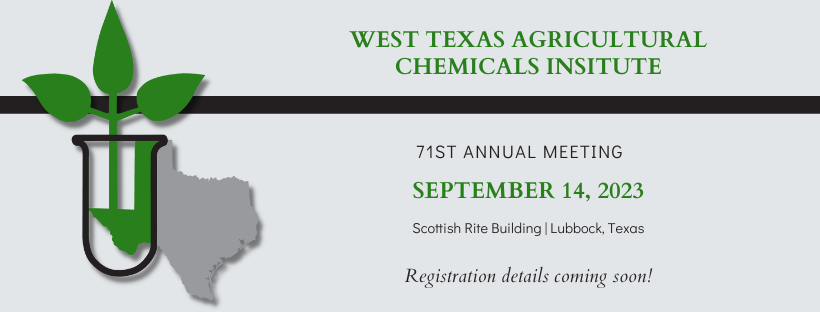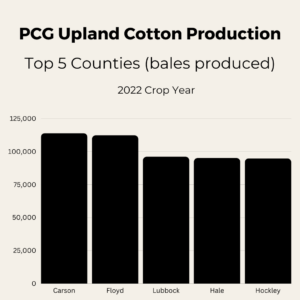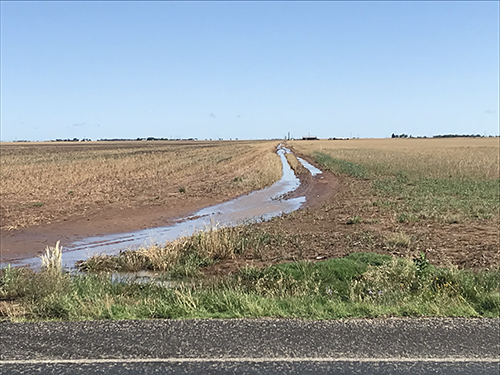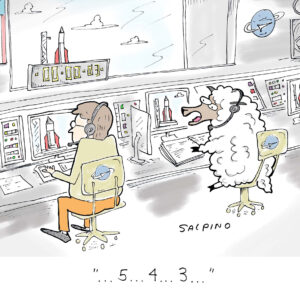Welcome to the May 26, 2023 issue of Cotton News, a service provided by Plains Cotton Growers Inc. for the cotton industry in the Texas High Plains and beyond.

Upland Cotton Production in the US, Texas and PCG Service Area
The U.S. Department of Agriculture (USDA) National Agricultural Statistics Service released its latest crop production report May 12, 2023.
2022 Production
According to the report, an estimated 13.6 million acres were planted nationwide. Seven million of those acres were harvested, producing nearly 14 million bales.
Texas planted 7.85 million acres, harvesting 2 million for an estimated production of 3 million bales.
The Texas High Plains planted roughly 4.8 million acres and harvested 961,000 of those acres for a production estimate of 1.5 million bales.
Carson County holds the title for most production in the 2022 crop year with 113,800 bales, while Hockley County came in fifth at 94,700 bales.
 A full report of PCG’s 42-county production numbers can be found here.
A full report of PCG’s 42-county production numbers can be found here.
2023 Forecast
USDA’s initial projection for 2023/24 U.S. cotton production is 15.5 million bales, 7% (1 million bales) above the final 2022/23 estimate. The Prospective Plantings report estimates 2023/24 cotton planted area at 11.3 million acres, 2.5 million acres below the 2022/23 estimate. Market price, weather, production costs and potential program benefits will all play a key role in determining planted cotton acres this year, according to the USDA Cotton and Wool Outlook report released in May. USDA will update the plantings estimate at the end of June.
Advisory Group Outlook

Mark Brown captured rain standing in a field in Crosby County. “It’s been months since I’ve seen something like that,” he said.
This morning (May 26, 2023) the Plains Cotton Advisory Group gathered to discuss crop conditions. Rather than focusing on the lack of rain, current weather conditions provided a new topic: planting when it’s wet.
While there are challenges associated with rain like difficulty in meeting planting deadlines, soil temperatures not quite warm enough and the increased potential for hail with weather events in this region, the overall consensus was summed up by South Texas Cotton and Grain Executive Director Jeff Nunley. “I will say, having moisture is way better than being dry.”
When 65% of the High Plains and the state consists of dryland cotton acres, rain is a necessity for higher production levels. To make an average or above average crop, the group agreed a dryland crop has to be made.
NASA’s Role in Agriculture
NASA expects to work more closely with farmers and other members of the agriculture community through a new program called Acres.
Established in March, Acres is a consortium of partners working across the U.S. agricultural spectrum to develop observatory-based data and tools to help increase food production, while protecting or restoring soil, water and other natural resources, says Alyssa Whitcraft, founding director and a professor in the department of geographical sciences at the University of Maryland. University staff provide administration and oversight for Acres.
Three of the consortium partners’ broad objectives for Acres include:
1. Supporting a deeper understanding of U.S. agricultural land use, productivity and sustainability.
2. Developing on-farm decision support tools for smart agronomy.
3. Strengthening environmental and human resilience to climate change and global hazards.
Ag Census Deadline: May 31
WUSDA’s National Agricultural Statistics Service (NASS) says the deadline for producers to return 2022 ag census forms is Wednesday, May 31, either by mail or online at www.agcounts.usda.gov.
USDA NASS is reminding ag census recipients that if they produced and sold $1,000 or more of agricultural product in 2022, or normally would have produced and sold that much, they meet USDA’s definition of a farm.
However, landowners who lease land to producers, those solely involved in conservation programs, and even those who may not have farmed in 2022 are still required to respond.
Producers who received the ag census but do not fit the definition of a farm, are no longer farming, never farmed, or have another update for NASS should write their status on the form and mail it back.
Ag census data are used by agribusinesses, educators, researchers, federal and local government, and many others when making decisions about farm programs, loans, insurance, rural development, disaster assistance, and more. Not responding means not being represented in these widely used data, and therefore risk being underserved. For assistance filling out the ag census, call 888-424-7828.